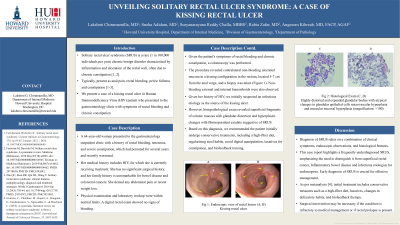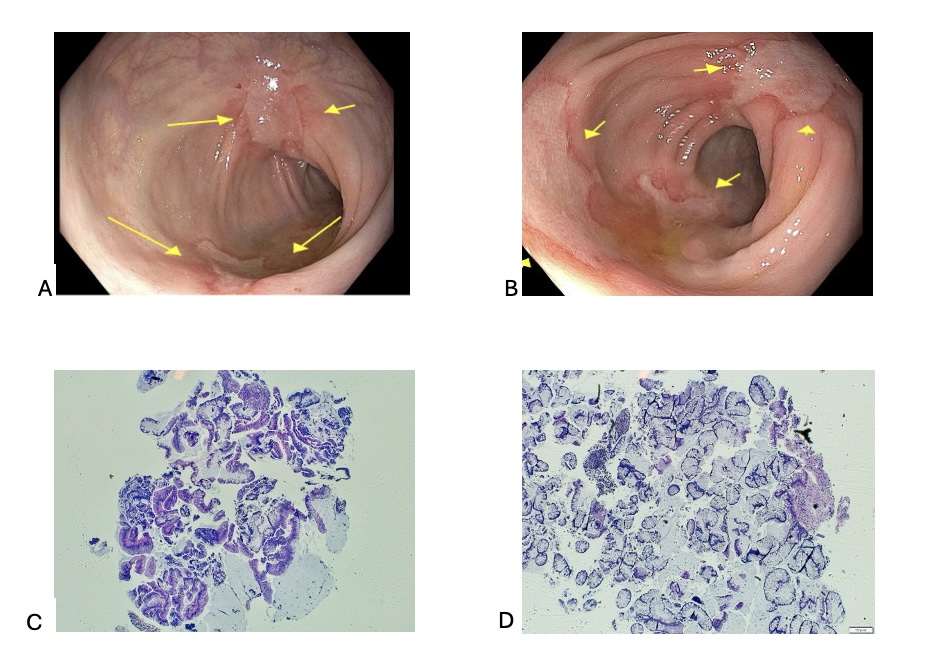Sunday Poster Session
Category: Colon
P0304 - Unveiling Solitary Rectal Ulcer Syndrome: A Case of Kissing Rectal Ulcer
Sunday, October 27, 2024
3:30 PM - 7:00 PM ET
Location: Exhibit Hall E


Lakshmi Chirumamilla, MD
Howard University Hospital
Herndon, VA
Presenting Author(s)
Lakshmi Chirumamilla, MD1, Sneha Adidam, MD2, Suryanarayana Challa Reddy, MBBS2, Rabia Zafar, MD2, Angesom Kibreab, MD2
1Howard University Hospital, Herndon, VA; 2Howard University Hospital, Washington, DC
Introduction: Solitary rectal ulcer syndrome (SRUS) is a rare (1 in 100,000 per year) chronic benign disorder characterized by inflammation and ulceration of the rectal wall, often due to chronic constipation [1, 2]. Typically present as anal pain, rectal bleeding, pelvic fullness and constipation [1-3]. We present a case of a kissing rectal ulcer in Human Immunodeficiency Virus (HIV) patient who presented to the gastroenterology clinic with symptoms of rectal bleeding and chronic constipation.
Case Description/Methods: A 64-year-old woman presented to the gastroenterology outpatient clinic with a history of rectal bleeding, tenesmus, and severe constipation, which had persisted for several years and recently worsened. Her medical history includes HIV, for which she is currently receiving treatment. She has no significant surgical history, and her family history is unremarkable for bowel disease and colorectal cancers. She denied any abdominal pain or recent weight loss.
Physical examination and laboratory workup were within normal limits. A digital rectal exam showed no signs of bleeding. Given the patient's symptoms of rectal bleeding and chronic constipation, a colonoscopy was performed. The procedure revealed contralateral non-bleeding ulcerated mucosa in a kissing configuration in the rectum, located 5-7 cm from the anal verge, and a biopsy was taken (Figure 1). Non-bleeding external and internal hemorrhoids were also observed.
Given her history of HIV, we initially suspected an infectious etiology as the source of the kissing ulcer. However, histopathological exam revealed superficial fragments of colonic mucosa with glandular distortion and hyperplastic changes with fibrinopurulent exudate suggestive of SRUS. Based on this diagnosis, we recommended the patient initially undergo conservative treatments, including a high-fiber diet, regularizing stool habits, avoid digital manipulation, laxatives for constipation, and biofeedback training.
Discussion: This case report highlights a frequently underdiagnosed SRUS, emphasizing the need to distinguish it from superficial rectal cancer, Inflammatory bowel disease and infectious etiologies for endoscopists. Early diagnosis of SRUS is crucial for effective management. As per metanalysis [4, 5], initial treatment includes conservative measures such as a high-fiber diet, laxatives, changes in defecatory habits, and biofeedback therapy. Surgical intervention may be necessary if the condition is refractory to medical management or if rectal prolapse is present.

Disclosures:
Lakshmi Chirumamilla, MD1, Sneha Adidam, MD2, Suryanarayana Challa Reddy, MBBS2, Rabia Zafar, MD2, Angesom Kibreab, MD2. P0304 - Unveiling Solitary Rectal Ulcer Syndrome: A Case of Kissing Rectal Ulcer, ACG 2024 Annual Scientific Meeting Abstracts. Philadelphia, PA: American College of Gastroenterology.
1Howard University Hospital, Herndon, VA; 2Howard University Hospital, Washington, DC
Introduction: Solitary rectal ulcer syndrome (SRUS) is a rare (1 in 100,000 per year) chronic benign disorder characterized by inflammation and ulceration of the rectal wall, often due to chronic constipation [1, 2]. Typically present as anal pain, rectal bleeding, pelvic fullness and constipation [1-3]. We present a case of a kissing rectal ulcer in Human Immunodeficiency Virus (HIV) patient who presented to the gastroenterology clinic with symptoms of rectal bleeding and chronic constipation.
Case Description/Methods: A 64-year-old woman presented to the gastroenterology outpatient clinic with a history of rectal bleeding, tenesmus, and severe constipation, which had persisted for several years and recently worsened. Her medical history includes HIV, for which she is currently receiving treatment. She has no significant surgical history, and her family history is unremarkable for bowel disease and colorectal cancers. She denied any abdominal pain or recent weight loss.
Physical examination and laboratory workup were within normal limits. A digital rectal exam showed no signs of bleeding. Given the patient's symptoms of rectal bleeding and chronic constipation, a colonoscopy was performed. The procedure revealed contralateral non-bleeding ulcerated mucosa in a kissing configuration in the rectum, located 5-7 cm from the anal verge, and a biopsy was taken (Figure 1). Non-bleeding external and internal hemorrhoids were also observed.
Given her history of HIV, we initially suspected an infectious etiology as the source of the kissing ulcer. However, histopathological exam revealed superficial fragments of colonic mucosa with glandular distortion and hyperplastic changes with fibrinopurulent exudate suggestive of SRUS. Based on this diagnosis, we recommended the patient initially undergo conservative treatments, including a high-fiber diet, regularizing stool habits, avoid digital manipulation, laxatives for constipation, and biofeedback training.
Discussion: This case report highlights a frequently underdiagnosed SRUS, emphasizing the need to distinguish it from superficial rectal cancer, Inflammatory bowel disease and infectious etiologies for endoscopists. Early diagnosis of SRUS is crucial for effective management. As per metanalysis [4, 5], initial treatment includes conservative measures such as a high-fiber diet, laxatives, changes in defecatory habits, and biofeedback therapy. Surgical intervention may be necessary if the condition is refractory to medical management or if rectal prolapse is present.

Figure: Figure 1: Endoscopic view of rectal lesion (A, B): Kissing rectal ulcer. Histological Exam (C, D): Highly distorted and expanded glandular bodies with atypical changes in glandular epithelial cells microvascular hyperplasia and muscular mucosal hyperplasia (magnification: ×100)
Disclosures:
Lakshmi Chirumamilla indicated no relevant financial relationships.
Sneha Adidam indicated no relevant financial relationships.
Suryanarayana Challa Reddy indicated no relevant financial relationships.
Rabia Zafar indicated no relevant financial relationships.
Angesom Kibreab indicated no relevant financial relationships.
Lakshmi Chirumamilla, MD1, Sneha Adidam, MD2, Suryanarayana Challa Reddy, MBBS2, Rabia Zafar, MD2, Angesom Kibreab, MD2. P0304 - Unveiling Solitary Rectal Ulcer Syndrome: A Case of Kissing Rectal Ulcer, ACG 2024 Annual Scientific Meeting Abstracts. Philadelphia, PA: American College of Gastroenterology.
